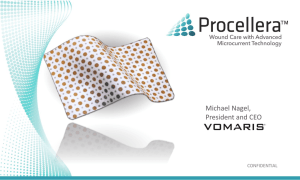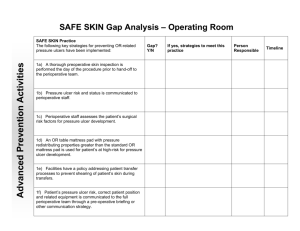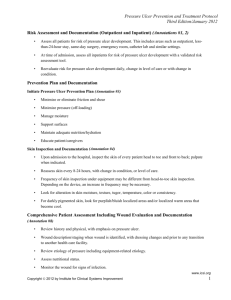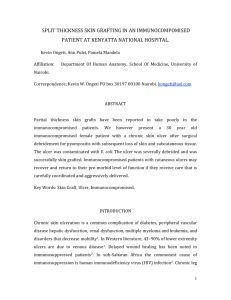NPWT-TNP article 030910
advertisement
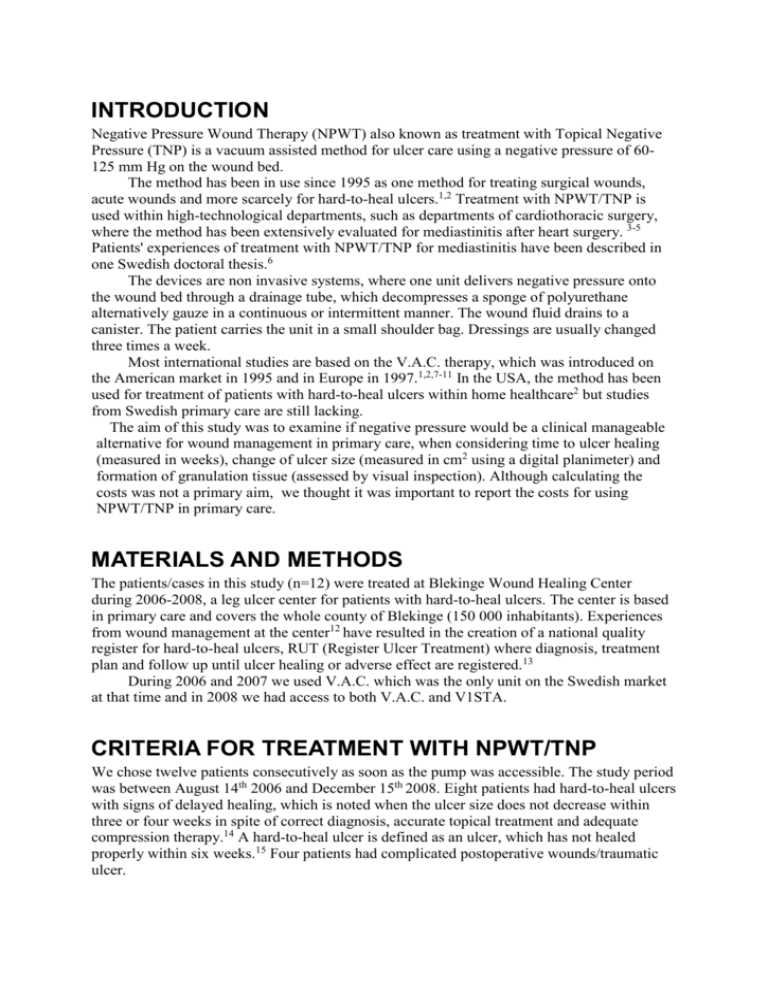
INTRODUCTION Negative Pressure Wound Therapy (NPWT) also known as treatment with Topical Negative Pressure (TNP) is a vacuum assisted method for ulcer care using a negative pressure of 60125 mm Hg on the wound bed. The method has been in use since 1995 as one method for treating surgical wounds, acute wounds and more scarcely for hard-to-heal ulcers.1,2 Treatment with NPWT/TNP is used within high-technological departments, such as departments of cardiothoracic surgery, where the method has been extensively evaluated for mediastinitis after heart surgery. 3-5 Patients' experiences of treatment with NPWT/TNP for mediastinitis have been described in one Swedish doctoral thesis.6 The devices are non invasive systems, where one unit delivers negative pressure onto the wound bed through a drainage tube, which decompresses a sponge of polyurethane alternatively gauze in a continuous or intermittent manner. The wound fluid drains to a canister. The patient carries the unit in a small shoulder bag. Dressings are usually changed three times a week. Most international studies are based on the V.A.C. therapy, which was introduced on the American market in 1995 and in Europe in 1997.1,2,7-11 In the USA, the method has been used for treatment of patients with hard-to-heal ulcers within home healthcare2 but studies from Swedish primary care are still lacking. The aim of this study was to examine if negative pressure would be a clinical manageable alternative for wound management in primary care, when considering time to ulcer healing (measured in weeks), change of ulcer size (measured in cm2 using a digital planimeter) and formation of granulation tissue (assessed by visual inspection). Although calculating the costs was not a primary aim, we thought it was important to report the costs for using NPWT/TNP in primary care. MATERIALS AND METHODS The patients/cases in this study (n=12) were treated at Blekinge Wound Healing Center during 2006-2008, a leg ulcer center for patients with hard-to-heal ulcers. The center is based in primary care and covers the whole county of Blekinge (150 000 inhabitants). Experiences from wound management at the center12 have resulted in the creation of a national quality register for hard-to-heal ulcers, RUT (Register Ulcer Treatment) where diagnosis, treatment plan and follow up until ulcer healing or adverse effect are registered.13 During 2006 and 2007 we used V.A.C. which was the only unit on the Swedish market at that time and in 2008 we had access to both V.A.C. and V1STA. CRITERIA FOR TREATMENT WITH NPWT/TNP We chose twelve patients consecutively as soon as the pump was accessible. The study period was between August 14th 2006 and December 15th 2008. Eight patients had hard-to-heal ulcers with signs of delayed healing, which is noted when the ulcer size does not decrease within three or four weeks in spite of correct diagnosis, accurate topical treatment and adequate compression therapy.14 A hard-to-heal ulcer is defined as an ulcer, which has not healed properly within six weeks.15 Four patients had complicated postoperative wounds/traumatic ulcer. From the author's experience, as a general practitioner with twenty years of special interest in leg ulcer care16, the study patients were representative of primary care with population heterogeneity, age profile, risk factors, ulcer etiology as well as treatment regimens before NPWT/TNP treatment. CONVENTIONAL TREATMENT BEFORE NPWT/TNP All study patients had been treated with conventional therapy, i.e. compression with 2-, 3- or 4- layer bandages depending on the Ankle Brachial Pressure Index (ABPI), intermittent pneumatic compression (IPC) when appropriate and dressings such as hydrocolloids, polyurethane dressings, topical antimicrobials (such as cadexomer iodine and silver) or larvae therapy and pinch grafting. Mean treatment time with conventional treatment before NPWT/TNP was 80 weeks (median 26 weeks). ANTIBIOTIC TREATMENT Bacterial cultures were only taken when there were signs of local ulcer infection.17,18 This was the case for two patients, who were treated with antibiotics for 10 days in accordance with swab results (Table 1, case 1,2). Another four patients had ongoing antibiotic treatment when treated at the Department of Infectious Diseases and the Orthopedic Department as well as in primary care (Table 1, cases 3,4,10,11). MEASURING THE ULCER SIZE One way to evaluate the effectiveness of a treatment is to measure ulcer size. We used a digital planimeter, which has been shown to be a reliable method. 19 It has also been demonstrated that if a selected treatment is effective, there should be a decrease with 20% 40% of the ulcer size within 2-4 weeks.14 Before treatment with NPWT/TNP, three patients had had surgical revision at hospital (Table 1, cases 3,4,11) which did not result in a reduction of ulcer size. FORMATION OF GRANULATION TISSUE Formation of granulation tissue was assessed by visual inspection at dressing changes. RESULTS We treated 12 patients (5 women and 7 men) with a median age of 57 years (range 32-81 years) (Table 1). Eight patients had hard-to-heal ulcers where the etiologies included two venous ulcers, three neuropathic foot ulcers in patients with diabetes mellitus, two pressure ulcers, and one venous - arterial ulcer. Three patients had postoperative wounds and one patient had a hydrostatic traumatic ulcer. The mean ulcer duration before treatment with negative pressure was 80 weeks (median 26 weeks) [range 2-416 weeks]. (Table 1) The mean treatment time with NPWT/TNP was 7.3 weeks (median 3 weeks). Treatment times for nine patients were between one and eight weeks, and for the remaining three patients were 16, 20 and 27 weeks respectively. WOUND HEALING Complete ulcer healing was assessed by visual inspection. 6/12 patients were healed entirely with a mean healing time of 11 weeks (median 9 weeks), (Table 1, cases 2,3,5,6,8,12). The patient with a hydrostatic traumatic ulcer healed within 8 weeks (Table 1, case 12). Two patients with postoperative wounds healed within 7 weeks (5 and 7 weeks respectively) while the third patient, with co-morbidities (such as diabetes mellitus and rheumatoid arthritis) was not healed at follow up (Table 1, case 11). CHANGE IN ULCER SIZE Mean ulcer size was reduced from 15.1 cm² (median 6.6 cm²) [range 0.3-76.8 cm²] before treatment to a mean of 13.5 cm² (median 3.0 cm²) after treatment. For one patient (Table 1, case 1) with venous ulcer the ulcer size increased during five weeks' treatment from 69.4 cm2 to 72.6 cm². In this case, treatment with NPWT/TNP contributed to the formation of granulation tissue. Also for the patient with a recurrence of pressure ulcer (Table 1, case 2), ulcer size increased from 3.5 cm2 to 4.7 cm2. For one patient with insulin treated diabetes mellitus and a heavy exudating neuropathic ulcer of the sole, treatment with NPWT/TNP for two weeks contributed to a reduction of the ulcer size by 33% (Table 1, case 4). However the patient refused continued treatment due to social reasons. FORMATION OF GRANULATION TISSUE For all 12 patients we found the fibrin on the wound bed replaced by granulation tissue after 1-3 weeks. We also found the ulcer edges less oedematous and a strong reduction of exudate, as illustrated by the patient with a pressure ulcer (Table 1, case 2). Before treatment with NPWT/TNP he had to change the dressings three times a day, due to heavy exudate, compared to three times a week during NPWT/TNP. COSTS FOR TREATMENT WITH NPWT/TNP (2009 PRICE LEVEL) The weekly mean costs of treatment with V.A.C. amounted to €339 and for V1STA to €279 including dressing material. Rental costs for the pumps were the main portion of the total cost, ; for V.A.C. 79% of the total costs and for V1STA 74 % of the total costs. CASE ILLUSTRATION One woman aged 73 (Table 1, case 3) with severe rheumatoid arthritis and reduced peripheral circulation serves as an illustration of our experience with NPWT/TNP. Due to a leg ulcer with no signs of healing, unbearable ulcer pain and no chance of surgical reconstruction, the orthopaedic surgeons considered amputation, which she refused. There appeared to be no likelihood of the ulcer healing and to avoid future pain and social distress, which most likely would end in amputation anyway, , she wanted to try treatment with negative pressure. Three weeks’ treatment with NPWT/TNP resulted in the formation of granulation tissue and reduction of oedema. Thereafter we used hydrocolloid dressings and reduced compression therapy for another 13 weeks until the ulcer was completely healed. (Figures 1A-1C). DISCUSSION We found that treatment with NPWT/TNP for wound management in primary care in half of the cases led to complete ulcer healing and in all cases accelerated the growth of granulation tissue. Our experience showed that treatment with NPWT/TNP could be used as a manageable method in primary care for treating pressure ulcers, venous or multi-factorial ulcers with signs of delayed healing and postoperative wounds/traumatic ulcers. Mean treatment time with NPWT/TNP in this study was 7.3 weeks (median 3 weeks). As for patients with diabetes mellitus and neuropathic foot ulcers they need a multidisciplinary approach for treatment, not only of their ulcer but to maintain metabolic status and to avoid the often harmful ulcer infection recognized in neuropathic foot ulcers.20,21 For these patients, treatment with NPWT/TNP should thus be introduced in collaboration with the Orthopedic Department or the diabetes foot ulcer team. In earlier studies on NPWT/TNP the researchers have concluded that this technology should be considered ”the treatment of choice” for chronic (hard-to-heal) ulcers due to its significant advantages concerning time for wound healing and ”wound bed preparation” compared with conventional therapy. 1,2,8 However, other researchers have reported that NPWT/TNP may improve wound healing but that the body of evidence available is insufficient to clearly prove an additional clinical benefit of this treatment.22,23 All patients in our study group had had conventional therapy with a mean of 80 weeks (median 26 weeks) before treatment with NPWT/TNP. Conventional therapy included compression with 2-, 3- or 4- layer bandages depending on the ABPI and IPC when appropriate and the use of dressings such as hydrocolloids, polyurethanes, topical antimicrobials (cadexomer iodine and silver) or larvae therapy and pinch grafting. When treated with either conventional therapy or with NPWT/TNP, therewas no reduction in ulcer size meeting the criteria of an effective treatment, defined as a 20% to 40% reduction of wound area within 2 and 4 weeks, which is said to be a reliable predictive indicator of healing specifically for venous leg ulcers.14 NPWT/TNP did not meet this criteria. We consider treatment with negative pressure in primary care, although manageable, to be one of many alternatives for ulcers with delayed healing. We do not agree with earlier researchers1,2,8 that NPWT/TNP should be ”the treatment of choice” for hard-to-heal ulcers in primary care. Although calculating the costs was not a primary aim, we found it important to note the costs for using NPWT/TNP in primary care. Costs for treatment with NPWT/TNP in one study were found to amount to approximately half the costs for conventional therapy.2 In our study we found that weekly costs for treatment with NPWT/TNP varied between €279 and €339 (at 2009 price levels) which would be roughly twice as high as was earlier reported for conventional therapy.24 The author has, as a general practitioner with special interest in leg ulcer care, twenty years’ knowledge of treating patients with hard-to-heal ulcers .12,16 In my experience wound management demands well organized teams around the leg ulcer patient, which is in accordance with findings in earlier studies25,26. Using modern treatment with NPWT/TNP in primary care thus requires teams with the skills and abilities to meet the challenges of introducing new techniques to achieve improved treatment outcomes.27 The problem of antibiotic resistance worldwide and especially in wound management has not been discussed in this study. However, it is thought that further studies on treatment with NPWT/TNP in infected hard-to-heal ulcers should be undertaken.28 From the author's experience the greatest benefit from using NPWT/TNP for patients with hard-to-heal ulcers or complicated postoperative wounds in primary care, is the formation of granulation tissue, which is a fundamental requirement in ulcer healing. Considering the small study size, the population heterogeneity and the treatment regimens before TNP/NPWT, our experience is that treatment with negative pressure could be used as a manageable alternative for wound management in primary care.


